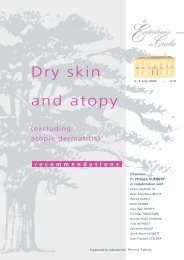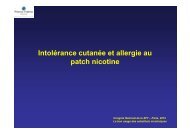Nicotine replacement therapy … - Carlos A ... - Entretiens du Carla
Nicotine replacement therapy … - Carlos A ... - Entretiens du Carla
Nicotine replacement therapy … - Carlos A ... - Entretiens du Carla
Create successful ePaper yourself
Turn your PDF publications into a flip-book with our unique Google optimized e-Paper software.
(23) Kapur B, Hackman<br />
R, Selby P, Klein J, Koren<br />
G. Randomized, doubleblind,<br />
placebo-controlled<br />
trial of nicotine<br />
<strong>replacement</strong> <strong>therapy</strong> in<br />
pregnancy. Current<br />
Therapeutic Research,<br />
Clinical & Experimental<br />
2001; 62(4): 274-278.<br />
(24) Hegaard HK,<br />
Kjaergaard H, Moller LF,<br />
Wachmann H, Ottesen B.<br />
Multimodal intervention<br />
raises smoking cessation<br />
rate <strong>du</strong>ring pregnancy.<br />
Acta Obstetricia et<br />
Gynecologica<br />
Scandinavica 2003; 82(9):<br />
813-819.<br />
(25) Pollak K, Oncken<br />
CA, Lipkus I, Lyna P,<br />
Swamy G, Pletsch P et al.<br />
Effectiveness of Adding<br />
<strong>Nicotine</strong> Replacement to<br />
Cognitive Behavioral<br />
Therapy for Smoking<br />
Cessation in Pregnant<br />
Smokers: The Baby<br />
Steps Trial. American<br />
Journal of Preventive<br />
Medicine. 2007; 33: 297-<br />
305.<br />
(26) Coleman T,<br />
Thornton J, Britton J,<br />
Lewis S, Watts K,<br />
Coughtrie MW et al.<br />
Protocol for the<br />
smoking, nicotine and<br />
pregnancy (SNAP) trial:<br />
double-blind, placeborandomised,<br />
controlled<br />
trial of nicotine<br />
<strong>replacement</strong> <strong>therapy</strong> in<br />
pregnancy. 1186. BMC<br />
Health Services Research<br />
2007; 7:2.<br />
women randomised to group. The nonblinded<br />
trial design could also have resulted<br />
in biased reporting of adverse events<br />
amongst the NRT group and although birth<br />
weight was monitored, no significant<br />
differences between trial arms were noted.<br />
Two observational epidemiological studies<br />
have investigated the relationship between<br />
NRT use in pregnancy and congenital<br />
abnormalities. One analysed data from<br />
almost 77,000 pregnancies within a Danish<br />
birth cohort, finding an association between<br />
reported nicotine use in the first trimester of<br />
pregnancy and subsequent foetal<br />
malformation (OR 1.61; 95% CI 1.01 – 2.58)<br />
(20). A second case control study, however,<br />
analysed data from almost 51,000 live births<br />
and compared pregnant women who had<br />
received prescriptions for NRT with those<br />
who did not but found no association<br />
between receiving NRT on prescription and<br />
foetal abnormality (OR 1.56; 95% CI 0.85 –<br />
2.86) (21). In both studies findings could have<br />
arisen because of unmeasured (and<br />
therefore non-adjusted for) factors causing<br />
confounding and further evidence is<br />
required.<br />
In summary, there is no compelling<br />
evidence that medicinal nicotine use in<br />
pregnancy is safer or more harmful than<br />
smoking and more research is required. The<br />
current expert consensus that using NRT is<br />
probably safer in pregnancy than smoking is<br />
predominantly based on theoretical<br />
considerations (10).<br />
<strong>Nicotine</strong> in pregnancy:<br />
effectiveness for smoking<br />
cessation<br />
Although NRT is of unquestionable<br />
effectiveness when used outside of<br />
pregnancy, pregnant women metabolise<br />
nicotine and cotinine 60% and 140% faster<br />
respectively than non-pregnant smokers<br />
(22).<br />
This means that standard does of nicotine<br />
<strong>replacement</strong> <strong>therapy</strong> may not generate<br />
sufficient plasma levels of nicotine in<br />
pregnant women to effectively substitute for<br />
the nicotine that they would have received<br />
by smoking: higher doses may be need in<br />
pregnancy for NRT to be effective.<br />
This could explain why the three trials<br />
meta analysed in the Cochrane review of<br />
smoking cessation interventions in<br />
pregnancy provide no evidence for the<br />
effectiveness of NRT when used for smoking<br />
cessation in pregnancy (9-18-23-24). The<br />
open-label RCT which was stopped <strong>du</strong>e to<br />
increased adverse events, and which is not<br />
included in the review analysis, did, however,<br />
pro<strong>du</strong>ce positive findings (25). This trial had<br />
two primary outcomes: seven day point<br />
prevalence smoking cessation at both 7 and<br />
38 weeks of pregnancy. At 7 weeks, 7 day<br />
point prevalence cessation was significantly<br />
higher in the NRT arm (24% vs. 8%) and at<br />
38 weeks, cessation in the NRT group was<br />
still greater (18% vs. 7%), but no longer<br />
statistically significant at ‘p’ value selected at<br />
the outset of the study (p=0.025 – to allow<br />
for two primary outcomes).<br />
There are currently three ongoing studies<br />
which should pro<strong>du</strong>ce further information of<br />
the safety and effectiveness of NRT in<br />
pregnancy. These include two placebo RCTs;<br />
one is based in Nottingham, England (26) has<br />
currently recruited 50% of its target and the<br />
second based in Paris, France and has<br />
recently started recruiting. A third openlabel<br />
RCT is based in the US and results are<br />
<strong>du</strong>e soon.<br />
Consequently, in the next 5 years there<br />
may be sufficient evidence to make more<br />
definitive statements about the effectiveness<br />
of NRT for smoking cessation in pregnancy,<br />
but currently there is no evidence other than<br />
theoretical, to suppose that it works.<br />
40






